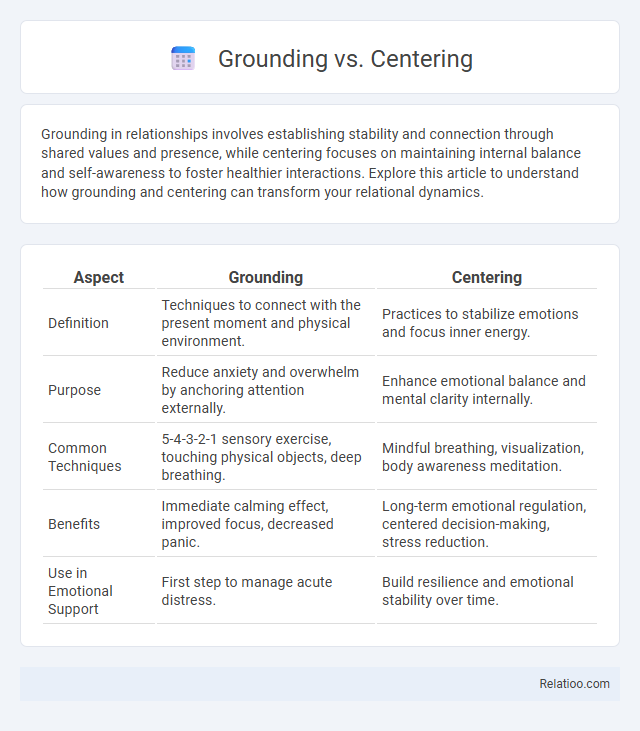Grounding in relationships involves establishing stability and connection through shared values and presence, while centering focuses on maintaining internal balance and self-awareness to foster healthier interactions. Explore this article to understand how grounding and centering can transform your relational dynamics.
Table of Comparison
| Aspect | Grounding | Centering |
|---|---|---|
| Definition | Techniques to connect with the present moment and physical environment. | Practices to stabilize emotions and focus inner energy. |
| Purpose | Reduce anxiety and overwhelm by anchoring attention externally. | Enhance emotional balance and mental clarity internally. |
| Common Techniques | 5-4-3-2-1 sensory exercise, touching physical objects, deep breathing. | Mindful breathing, visualization, body awareness meditation. |
| Benefits | Immediate calming effect, improved focus, decreased panic. | Long-term emotional regulation, centered decision-making, stress reduction. |
| Use in Emotional Support | First step to manage acute distress. | Build resilience and emotional stability over time. |
Understanding Grounding: Definition and Purpose
Grounding refers to the process of connecting oneself mentally and emotionally to the present moment, enhancing awareness and stability during stressful situations. Centering involves focusing attention inward to balance emotions and thoughts, promoting calmness and control. While both techniques improve mindfulness, grounding specifically aims to anchor individuals in reality by using sensory input and physical sensations to reduce anxiety and dissociation.
What Is Centering? Key Concepts Explained
Centering involves focusing your attention inward to stabilize your mind and body, creating a sense of calm and balance essential for mental clarity. Key concepts include mindfulness, breath awareness, and present-moment focus, which help reduce stress and improve emotional regulation. Your ability to center enhances decision-making and promotes a grounded state that supports overall well-being.
Grounding vs Centering: Core Differences
Grounding involves connecting thoughts and emotions to the present moment to reduce anxiety and increase awareness, while centering focuses on balancing inner energy and fostering a sense of stability and calm. Grounding techniques often use physical sensations and external stimuli for immediate presence, whereas centering employs mental or spiritual exercises to harmonize the mind and body. Understanding these differences is crucial for selecting the appropriate practice in stress management or mindfulness routines.
Common Techniques for Grounding
Common techniques for grounding include sensory awareness practices such as focusing on tactile sensations, like holding a textured object, or engaging with natural elements like soil or water. Visualization exercises, where you imagine roots extending from your feet into the earth, help stabilize your energy and create a sense of security. These methods support your ability to remain present and connected during stressful moments.
Effective Methods for Centering
Effective methods for centering involve mindfulness practices such as focused breathing, body scanning, and visualization techniques that anchor attention to the present moment. Grounding techniques emphasize physical connection to the environment through sensory awareness like feeling the ground beneath the feet or holding an object, while centering methods cultivate internal balance and emotional regulation by aligning mental focus and energy. Incorporating both grounding and centering strategies enhances overall stability, reduces anxiety, and improves mental clarity.
Benefits of Grounding Practices
Grounding practices enhance emotional regulation by anchoring individuals in the present moment, reducing anxiety and stress responses effectively. They improve mental clarity and focus, enabling better decision-making and enhanced cognitive performance during high-pressure situations. Consistent grounding techniques also promote resilience by fostering a stable connection between mind and body, supporting overall well-being and mental health.
Advantages of Centering Exercises
Centering exercises help you enhance mental clarity by focusing your attention inward, reducing stress and promoting emotional balance. These techniques improve your ability to stay present and grounded in the moment, which boosts concentration and decision-making skills. By practicing centering regularly, you can experience greater calmness and resilience in challenging situations.
When to Use Grounding vs Centering
Grounding is used when establishing a sense of stability and presence by connecting to the physical environment or sensations, often helpful during anxiety or stress. Centering is applied to bring mental focus and alignment by calming the mind and balancing emotions, ideal before meditation or decision-making. Use grounding techniques to anchor awareness in the here and now, while centering techniques are best for achieving inner equilibrium and clarity.
Combining Grounding and Centering for Balance
Combining grounding and centering techniques enhances your ability to achieve emotional and mental balance by stabilizing your energy and focusing your awareness simultaneously. Grounding connects you to the present moment and physical sensations, while centering aligns your inner focus and calmness, creating a harmonized state ideal for managing stress and improving mindfulness. Practicing these together fosters resilience, clarity, and a deeper sense of equilibrium in everyday life.
Tips for Integrating Both into Daily Life
Grounding techniques like deep breathing and sensory awareness help You stay connected to the present moment, reducing anxiety and stress effectively. Centering involves focusing Your mental and emotional energy on a single point, often through meditation or visualization, enhancing clarity and calmness. Integrate both by starting Your day with mindful grounding exercises followed by centering practices to balance mental focus and emotional stability throughout daily life.

Infographic: Grounding vs Centering
 relatioo.com
relatioo.com